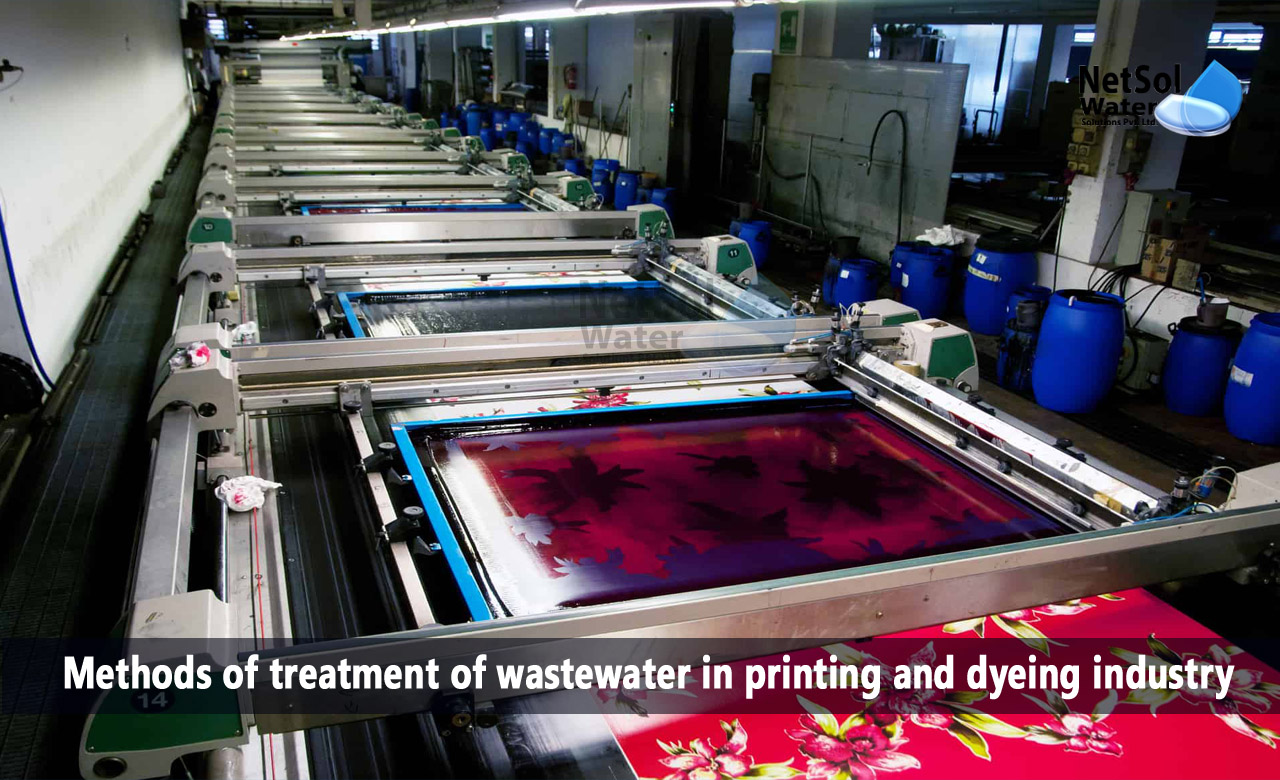Wastewater from printing and dyeing processes makes up a sizable fraction of all industrial effluent discharges, and the wastewater is highly salted, highly coloured, and contains large amounts of organic materials.
The majority of industrial dyes nowadays tend to be resistant to photolysis, oxidation, and biological oxidation, which makes wastewater treatment even more challenging, especially in recent years with the rise in product quality. The enhanced treatment and resource reuse of wastewater from printing and dyeing have drawn more and more attention, as water resources become scarcer.
Let’s look at some of the methods for the treatment of wastewater in printing and dyeing industry.
Composition of printing and dyeing industry wastewater
The textile, printing, leather tanning, cosmetic, pharmaceutical, and food processing sectors, all use synthetic dyes extensively. It is one of the most polluting industrial areas. The printing method is quite flexible and may be used to print on a variety of materials, including paper, textiles, and plastic and other materials.
Several chemicals, including ethers, alcohols, phenols, aldehydes, ketones, benzene, and esters, are employed in the cleaning process after the printing process is finished. The difficulty of treating wastewater is further increased, by the fact that resultant effluent frequently contains a range of solvents, surfactants, dyes, and other compounds.
The implications of improperly disposing of printing and dyeing effluent into water bodies are numerous, starting with aesthetic concerns and progressing to the aquatic ecosystem's demise, as a result of light attenuation, oxygen consumption, and toxicity impacts. Therefore, it is crucial to research and improve wastewater treatment methods for printing and dyeing.
So how should we handle wastewater from printing and dyeing? Let's examine the following techniques:
What methods to treat wastewater in printing and dyeing industry?
1. Adsorption Treatment
The most widely utilized adsorbent in the improved treatment of wastewater from printing and dyeing is activated carbon. It is particularly suited for the de-colorization of water-soluble dyes with a relative molecular mass of less than 400, and exhibits high adsorption and de-colorization performance.
The implementation of the adsorption method in the advanced treatment of printing and dyeing wastewater, is constrained by activated carbon's low adsorption impact on hydrophobic colours, and the difficulty and cost of its regeneration.
2. Technology using Membrane Separation
The enhanced treatment of printing and dyeing wastewater mostly uses Microfiltration (MF), Ultrafiltration (UF), Nanofiltration (NF), and Reverse Osmosis, as the membrane separation technologies.
UF can separate macromolecular organic matter, colloids, and suspended solids; NF can desalinate and concentrate at the same time; RO can remove soluble metal salts, organic matter, colloidal particles, etc.; and it can intercept all ions. MF and UF are frequently used as the pretreatment of NF and RO.
With high removal efficiency and ease of use, Netsol Water Solutions’ offers a variety of RO Plants with different capacities, which are appropriate for pre-filtering printing and dyeing wastewater. It can also remove inorganic salts and prevent the build-up of inorganic salts in the system, in addition to removing any remaining organic matter from the water and lightening its colour with activated carbon filters. It is an innovative method for treating effluent from printing and dyeing processes.
3. Technology for Electrochemical Oxidation
A significant amount of free radicals are produced in a specific reactor under the influence of an external electric field, through a particular chemical reaction, electrochemical process, or physical process, and the process of using the strong oxidising property of free radicals to degrade pollutants in wastewater. The advantages of electrochemical technology are simplicity, low or no emissions, and high versatility.
Physical, chemical, biological, and more recently, hybrid processes can be used to remove dye from wastewater. Adsorption is a physical process that uses a mass transfer mechanism and is widely utilized, since it is simple to use and effective. Due to chemical use, equipment needs, and electrical energy consumption, chemical treatments including coagulation and flocculation, sophisticated oxidation processes, and electrochemical treatment are typically more expensive.
A low-cost, ecologically beneficial approach that creates less sludge is biological treatment. Although, this approach has several benefits, dye molecules are less susceptible to it because they are designed to be stable and resistant.
Therefore, adjusting and improving biological treatment for dye removal is a growing area of study. In recent studies, hybrid procedures that combine various techniques have drawn increased attention. The best way to treat printing wastewater is by integrating treatments as a time and money-saving process.
Conclusion
There are numerous single methods for the improved treatment of wastewater from printing and dyeing processes, and while each has pros and cons, it is challenging for all of them to meet the standards for discharge and repurposing.
To increase the degree of wastewater treatment, it is necessary to select and optimise combined treatment methods, based on the features of printing and dyeing wastewater quality.
Pick India's top wastewater treatment plant suppliers for the printing and dyeing industries!
Our goal at Netsol Water is to help commercial and industrial businesses with their water treatment needs, by offering high-performing water and wastewater treatment solutions. Our clients will experience decreased running costs and an extended equipment lifespan, thanks to the excellent service and water treatment options we offer.
Installation, manufacturer's warranty, and 24-hour customer assistance are all included with every purchase of these systems. For further information, call us at +91 9650608473 or send an email to enquiry@netsolwater.com



